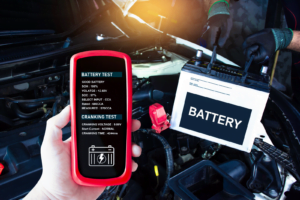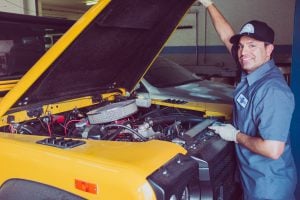Fuel economy can be maintained and improved by following the tire pressure recommendation for your vehicle. The tires on your vehicle are the only part of your vehicle to make contact with the road surface. Making them a critical component in how your vehicle operates. Tires are responsible for the following:
- 1) Achieving fuel economy targets
- 2) Transferring the weight of the vehicle and load safely to the road surface
- 3) Providing a comfortable ride by reducing road noise
- 4) Allowing the vehicle to travel through different temperatures
- 5) Allowing the vehicle to travel through different weather systems
How Tire Pressures are Determined
The auto manufacturer works with the tire manufacturer to determine the best tire for the vehicle when taking into account the following:
- 1) Vehicle weight
- 2) Vehicle size
- 3) Towing capability
- 4) Size of tire
The tire recommended for your vehicle has been optimized for all these requirements. These specifications are posted on a tire placard, usually inside the driver’s door.

This placard provides the tire size for the front, rear, and spare tire. It will also specify the cold pressure. Tire pressures are either measured in KPA or PSI. Once hot, a tire can expand by up to 4 PSI, so checking them when cold is optimal. A cold tire has been driven for 1-2 miles.
Tire Pressure Monitoring Systems (TPMS)
Modern vehicles are equipped with TPMS that continuously measures pressures once they drop below a certain threshold. In some cases, this is 25% below cold pressure. However, these systems vary significantly across manufacturers, with some showing the actual tire reading and others simply indicating a low pressure with a warning light.
How to Maintain Tire Pressure
One of the most basic maintenance items you can do on your vehicle is to purchase a high-quality tire pressure gauge (around $20) that is either mechanical or digital. Use this tool to check your cold tire pressure first thing in the morning before driving about once a week. Other key times to check your tire pressure are when planning a road trip, hauling a trailer, or more weight than usual. Your tire pressure being off by 1 PSI can reduce overall fuel economy by .2% . Although a small %, this does add up over the course of a year. As noted earlier, if your TPMS is only triggered with significant drops in tire pressure, you could be wasting fuel due to low tire pressure by the time you find out.
Tire Maintenance
Other factors to consider outside of tire pressure but related to your tires to ensure the best fuel economy include:
1) Over inflation – a tire that exceeds the manufacturer’s recommended cold tire pressure will impact ride quality and could lead to tire damage if an obstacle like a pothole is hit. It may not significantly impact your fuel economy but will compromise the tire’s safety.
2) Tread depth – your tires have a built-in wear bar or indicator that when the tire gets to 2/32″ of an inch, it’s time for a new tire. Checking tires for wear can ensure that all 4 tires making contact with the road are in the best condition possible.
3) Tire rotation – your manufacturer will have a rotation schedule and pattern to follow, allowing for the most even wear on your tires. Following this schedule will allow for consistent wear across all 4 tires.
4) Tire alignment – aligning the tires ensures that any vehicle pulling to one direction will be corrected before it leads to significant tire wear.
Conclusion
Outside of tire pressure, these other elements help ensure your tires wear uniformly, and you can catch an issue before it compromises the tire safety and, potentially, the fuel economy. Keeping the rubber that hits the road in top shape will ensure you maintain peak fuel economy.






